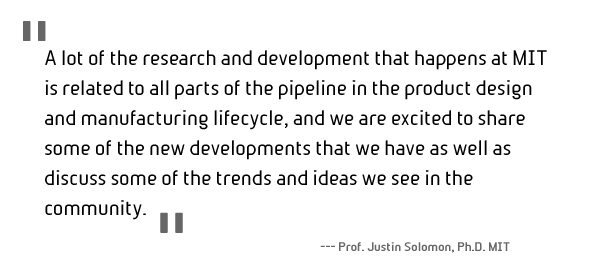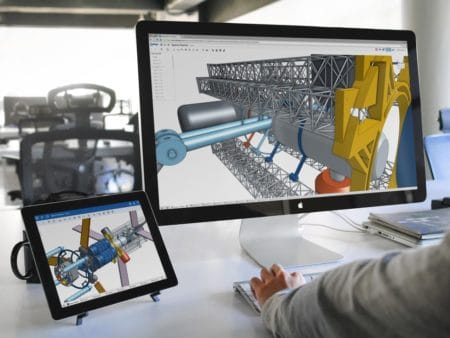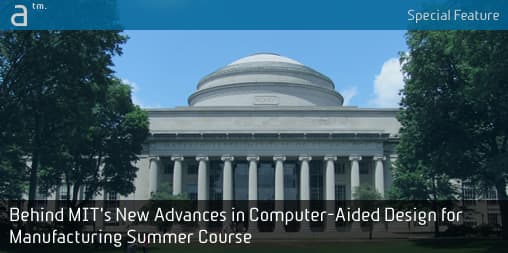Earlier this year MIT contacted Architosh to let us know that MIT’s Professional Education program was launching a new CAD course for the manufacturing market. Like many universities, MIT has a robust professional education set of tracks, courses and certification offerings in a variety of fields. However, this course is a bit of a novel offering in the professional educational programs at MIT.
Named “Advances in Computer-Aided Design for Manufacturing” the MIT Professional Education course will launch this coming summer at MIT’s famed Cambridge, Massachusetts campus and will be led by two instructors: Professor Wojciech Matusik, Assistant Professor of Electrical Engineering and Computer Science at the Computer Science and Artificial Intelligence Laboratory at MIT and Professor Justin Soloman, Assistant Professor of Electrical Engineering and Computer Science also at the Computer Science and Artificial Intelligence Laboratory at MIT.
The manufacturing world is undergoing tremendous change. Robotics, nano-scale device capabilities, 3D printing, and additive manufacturing are transforming what is possible to manufacture. But the list of advancing technologies doesn’t stop there. New software aimed at simulation, optimization, and shape-finding are also giving manufacturers and product designers new opportunities. How do all these new technologies change the way products are conceived and manufactured? And what in particular does this mean for computer-aided design for manufacturing?
These questions are at the heart of MIT’s new professional educational course, and both MIT professors spoke to Architosh about these questions and how their course will provide their students with a superior overview and look into the advances in computer-aided design for manufacturing.
The following excerpts have been edited and condensed for clarity.
The Interview
Why is MIT Professional Education adding a course on CAD technologies in the manufacturing world?
(Justin Solomon) Just in the last few years, we have seen a lot of new development in CAD technology—in the software, in the powerful new computational tools, in the new modeling technologies, and the new hardware. This progress also includes collaborative software, for example, in the Onshape software that we are going to use in the course.
A lot of the research and development that happens at MIT is related to all the parts of the pipeline in the product design and manufacturing lifecycle, and we are excited to share some of the new developments that we have as well as discuss some of the trends and ideas that we see in the community.

(Wojciech Matusik) I will add that there is a lot of progress in the manufacturing hardware itself, in things like 3D printers, additive manufacturing. These are expanding, and their use is not just for rapid-proto-typing anymore but actually for full manufacturing through 3D printers and how you construct final products.
So, do you see these manufacturing advances like additive manufacturing increasing demand for CAD tools?
Yes. There is going to be more and more CAD software taking advantages of additive manufacturing and 3D printing. Firstly, you have much greater freedom of form as you are no longer restricted by the form imposed by the traditional manufacturing process itself. And the second thing is you can use new and different types of materials. This applies to both polymer and metal type manufacturing but also to multi-material manufacturing.
Will students in your course get a chance to get involved in some additive manufacturing directly?
Yes. We will be designing a sample part using CAD software, and of course, students will be a part of the manufacturing process, and they will learn a little bit of that as well—and through the machines and how they work and so on.
So as the manufacturing world embraces these new 3D printing and additive manufacturing tools, how do you see the CAD industry evolving and adapting to this change?
(Soloman) Well, I suppose we are going to see a huge class of new things being made that could never be made before without this type of equipment. So the CAD software needs to respond to this added flexibility in the manufacturing market; it needs to allow the software to leverage the hardware in new ways as well as allow the user to reason and think about all of the new possibilities they now have for designing a new shape or part or assembly.
(Matusik) To go into a bit more detail, there are a lot of things happening in terms of additive manufacturing capabilities. For example, we can now manufacture increasingly small-scale structures—like micro-scale structures—that can be embedded in larger structures; so regarding form, you can develop parts at a much finer level.

01 – Onshape has been chosen as the software system for the MIT CAD summer course due to its ease of deployment and because it represents many of the new advancements in the MCAD industry. Image: Onshape. All rights reserved.
So if you are talking about multi-material 3D printing, we can now think about the distribution of materials throughout the volume of the objects at voxel level granularity. So this opens up the door and generates a new demand for new types of CAD systems or new types of CAD plugins, and we will be looking at some of those with the students as well.
So are these plugins something that will be running on top of Onshape? And speaking of that, why don’t you tell me about your decision to chose Onshape as the platform tool for this course. What’s behind that decision?
(Soloman) We selected Onshape largely because our course is just a week and we are attracting students from many different backgrounds and locations all coming to MIT. One of the big advantages of Onshape is that it is really simple to get started. It simply runs on your browser. And you can put everyone on the same page without a lot of setup quite quickly. Another advantage is that Onshape enables collaboration tools that allow you to work together over the Internet—again without needing a whole bunch of infrastructure.
And will students be simulating a type of collaborative structure the kind that they would see out in the market?
(Matusik) Yeah. We will try to have some of this type of experience, basically joint design sessions, “hack-up” style design sessions, where a few groups of students will compete for the best design.
So you will have some competitions inside the class…. Interesting.
Friendly competitions. (laughs…)
How would you boil down your primary goals of the course? What’s the big takeaway?
(Soloman) I guess our goal is to cover the CAD pipeline end to end—to show how recent developments have changed things—showing how from designing an object, to optimizing it for a particular physical purpose…and the manufacturing. Our goal is also to show students how CAD systems are built and expose them to modern types of CAD software, simulation software, optimization and generative design software.
Is there an ideal type of student for this course? You listed many types of folks on your website course page. Who is the sweet spot professional for this course, if there is one?
(Matusik) There isn’t one. We don’t assume a lot of background and knowledge here. The course is slightly condensed but after the course the students will have a very good idea about how these systems work, what their capabilities are, what types of approaches to use for particular tasks, and also they will get a lot of knowledge about how these systems work internally but how they work from the perspective of the user.
Can you give me your high-level perspective on the disruption of these emerging technology domains in CAD?
Absolutely. There are two different classes of designing things. One of them is directly specifying your shape. And the other one is starting with an assumption; basically, you start with specifying what that product is supposed to do. And essentially the computational component of the software is going to come up with the shape—or optimize the shape—that best meets these specifications. Both of these have a place in the manufacturing computer-aided design (MCAD) world.
Is this second class of designing things taking hold?
So far this generative design—of designing from specifying function—is somewhat underutilized. We see it being used more and more, specifically in the cases when your manufacturing capabilities can open up to creating new types of shapes. With “direct design” that can be very difficult. So we see more and more generative design tools being used because they are going to tame the complexity of the 3D design space.
How specifically does this taming of complexity taking place, what is actually happening?
3D printers allow you to tune millions of parameters around an object and of course the human brain can only wrap itself around a few dozen of these at a time. Algorithmic design tools can help you work at a higher level, specifying the requirements and letting the software solve around these.
Do you see this generative design driving a new skill set for the traditional person who would be using manufacturing design software?
The skill set is going to be somewhat different because instead of specifying the object surface by surface or part by part, you will be specifying the function. And then the computational system is going to do a lot of the design for you.

(Soloman) And you also need to understand what is going on under the hood so you can work with these new tools somewhat effectively.
You develop software tools at MIT. Will students get a front-row seat to this process and will you show them some of the tools you both have been involved in developing?
(Matusik) So we are going to be showing some of our tools that we have developed in our research front [at MIT]. Specifically, we will be showing students some of the topology optimization software packages.
This sounds like an amazing course.
I think the students are going to have a lot of fun during this week. They will have a sense of accomplishment, and we are extremely excited about this course.
About The MIT Course
Architosh wrote about “Advances in Computer-Aided Design for Manufacturing” an MIT Professional Education course being taught this coming summer at MIT in Cambridge in our earlier report here. To register or learn more for the course follow this link.
About The Instructors
Wojciech Matusik
Professor Wojciech Matusik is an Associate Professor of Electrical Engineering and Computer Science at the Computer Science and Artificial Intelligence Laboratory at MIT, where he leads the Computational Fabrication Group. Before coming to MIT, he worked at Mitsubishi Electric Research Laboratories, Adobe Systems, and Disney Research Zurich. He studied computer graphics at MIT and received his Ph.D. in 2003. He also received a BS in EECS from the University of California at Berkeley in 1997 and MS in EECS from MIT in 2001. His research interests are in direct digital manufacturing and computer graphics. He holds more than 40 US patents. In 2004, he was named one of the world’s top 100 young innovators by MIT’s Technology Review Magazine. In 2009, he received the Significant New Researcher Award from ACM SIGGRAPH. In 2012, PI Matusik received the DARPA Young Faculty Award and was named a Sloan Research Fellow. He currently serves on the DARPA ISAT Study Group.
Justin Soloman
Professor Justin Solomon is an Assistant Professor of Electrical Engineering and Computer Science at the Computer Science and Artificial Intelligence Laboratory at MIT, where he leads a new Geometric Data Processing Group. Before joining the MIT faculty, Solomon was an NSF Mathematical Sciences Postdoctoral Research Fellow in Princeton’s Program in Applied and Computational Mathematics. He received his Ph.D. in computer science from Stanford University in 2015, where he also received an MS in computer science (2012) and a BS in mathematics and computer science (2010). During his Ph.D., Solomon was supported by the National Defense Science and Engineering Graduate Fellowship (NDSEG), the Hertz Fellowship, and the NSF Graduate Research Fellowship Program (GRFP). Solomon also has worked at Pixar Animation Studios (2007-2012) and MITRE Corporation (2005-2007). His textbook Numerical Algorithms covers numerical methods for geometry, graphics, robotics, and other computational applications.
Image Credits: The hero image is by John Phelan released under Creative Commons (CC BY 3.0)




Reader Comments
Comments for this story are closed